Laws20060 Taxation Law Assignment: Residency, Income, Deductions Memo
VerifiedAdded on 2022/09/22
|17
|3467
|27
Project
AI Summary
This assignment presents a comprehensive analysis of Australian taxation law, encompassing two primary parts. Part A focuses on a case study, advising a hypothetical taxpayer, Rachel, on her residency status under Australian tax law, considering the relevant tests and provisions of the ITAA 1997. The analysis explores the ordinary resident test, domicile test, 183-days test, and superannuation test to determine Rachel's residency for different periods of the income year. Part B involves preparing a memo for 123 Accounting Pty Ltd, addressing objections to a 2018 Notice of Amended Assessment for Julie Banks. The memo examines assessable income, particularly the treatment of salary received and the timing of income recognition. It also addresses allowable deductions, including expenses related to a Facebook business page, clothing expenses, and home office expenses, referencing relevant legislation and case law such as FCT v Stone (2005) and Mansfield v FCT (1996) to support arguments regarding business activities and deductibility of expenses. The assignment demonstrates information literacy and problem-solving skills in identifying tax issues and applying legal principles to provide advice and recommendations.
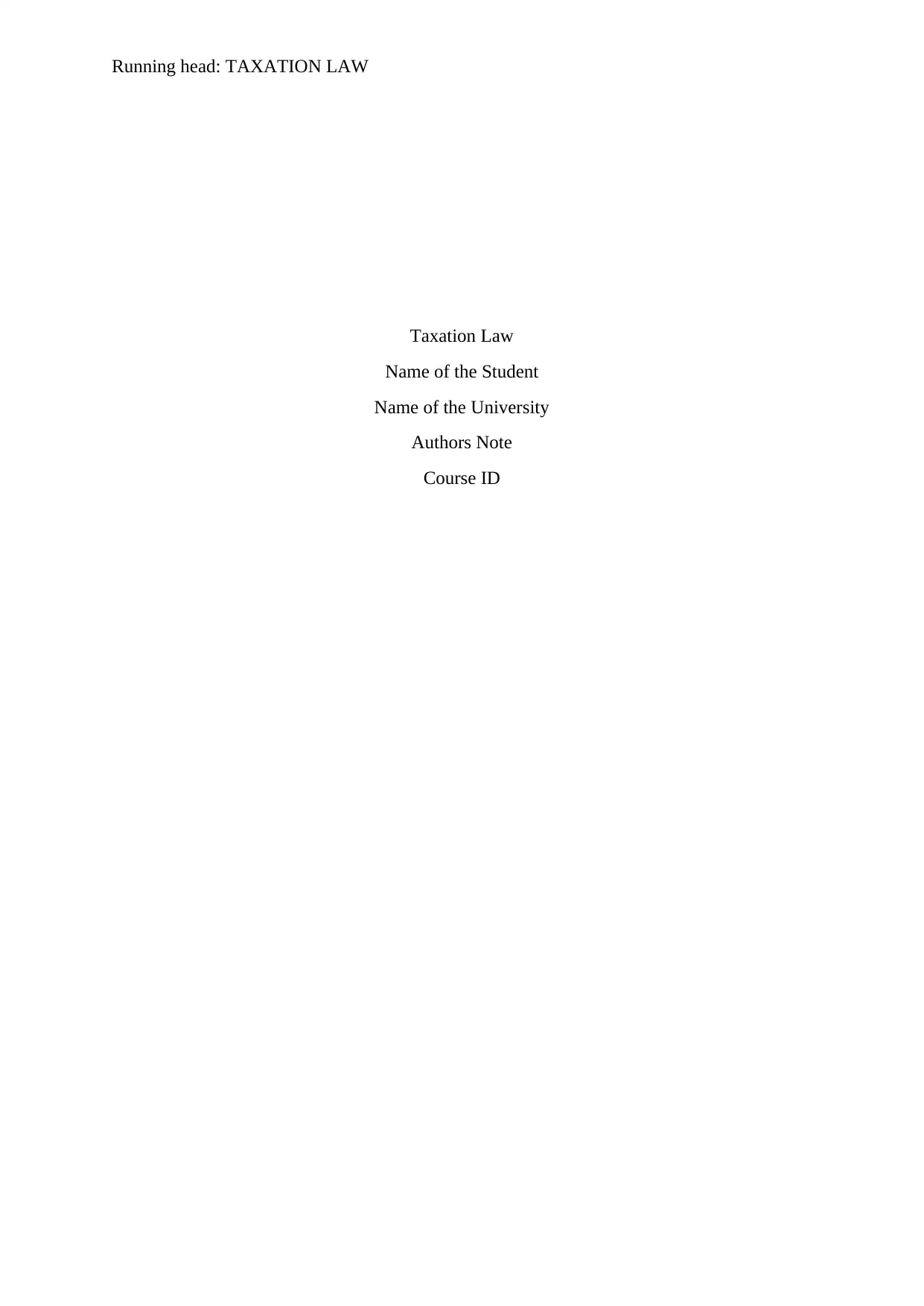
Running head: TAXATION LAW
Taxation Law
Name of the Student
Name of the University
Authors Note
Course ID
Taxation Law
Name of the Student
Name of the University
Authors Note
Course ID
Paraphrase This Document
Need a fresh take? Get an instant paraphrase of this document with our AI Paraphraser
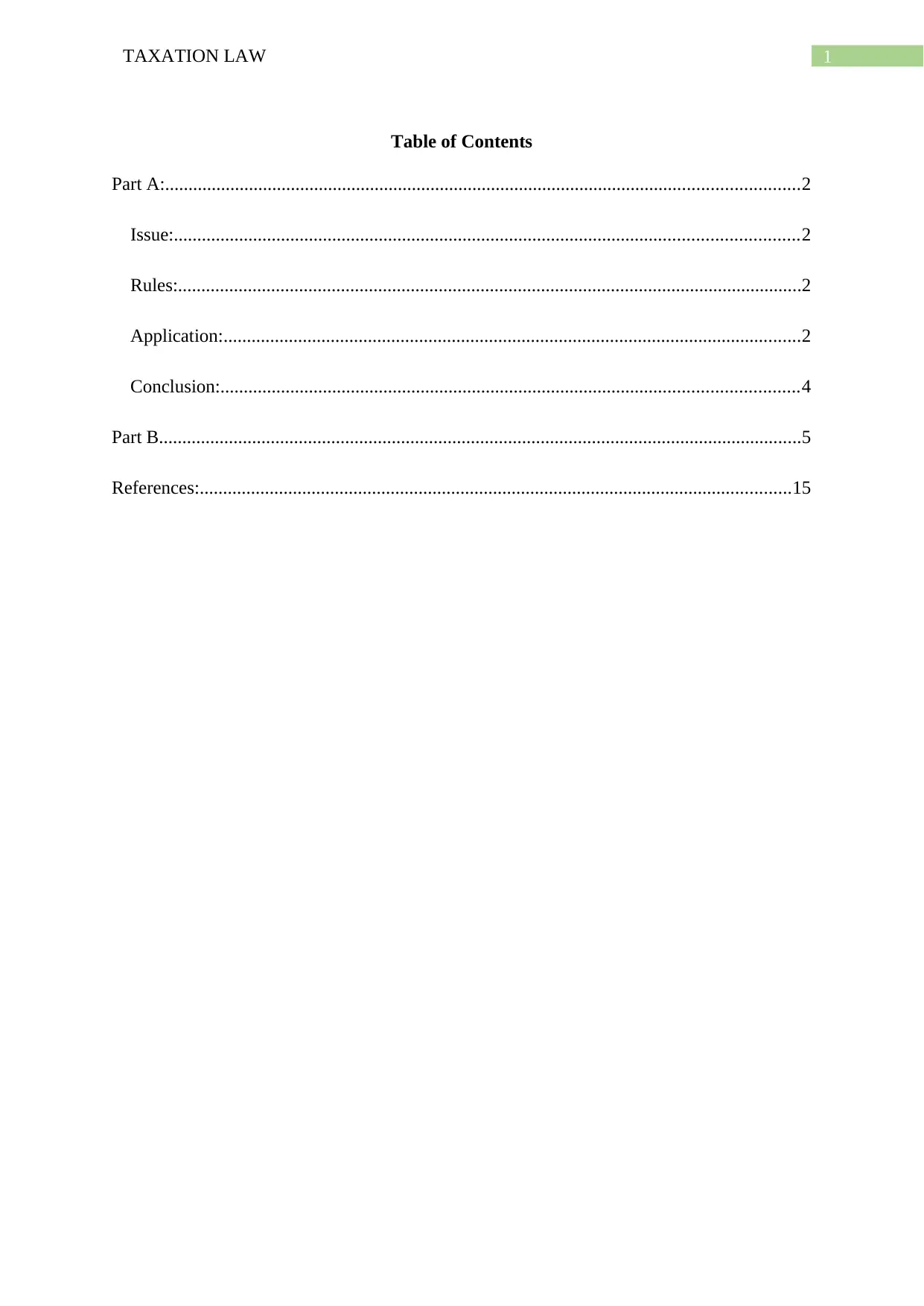
1TAXATION LAW
Table of Contents
Part A:........................................................................................................................................2
Issue:......................................................................................................................................2
Rules:......................................................................................................................................2
Application:............................................................................................................................2
Conclusion:............................................................................................................................4
Part B..........................................................................................................................................5
References:...............................................................................................................................15
Table of Contents
Part A:........................................................................................................................................2
Issue:......................................................................................................................................2
Rules:......................................................................................................................................2
Application:............................................................................................................................2
Conclusion:............................................................................................................................4
Part B..........................................................................................................................................5
References:...............................................................................................................................15
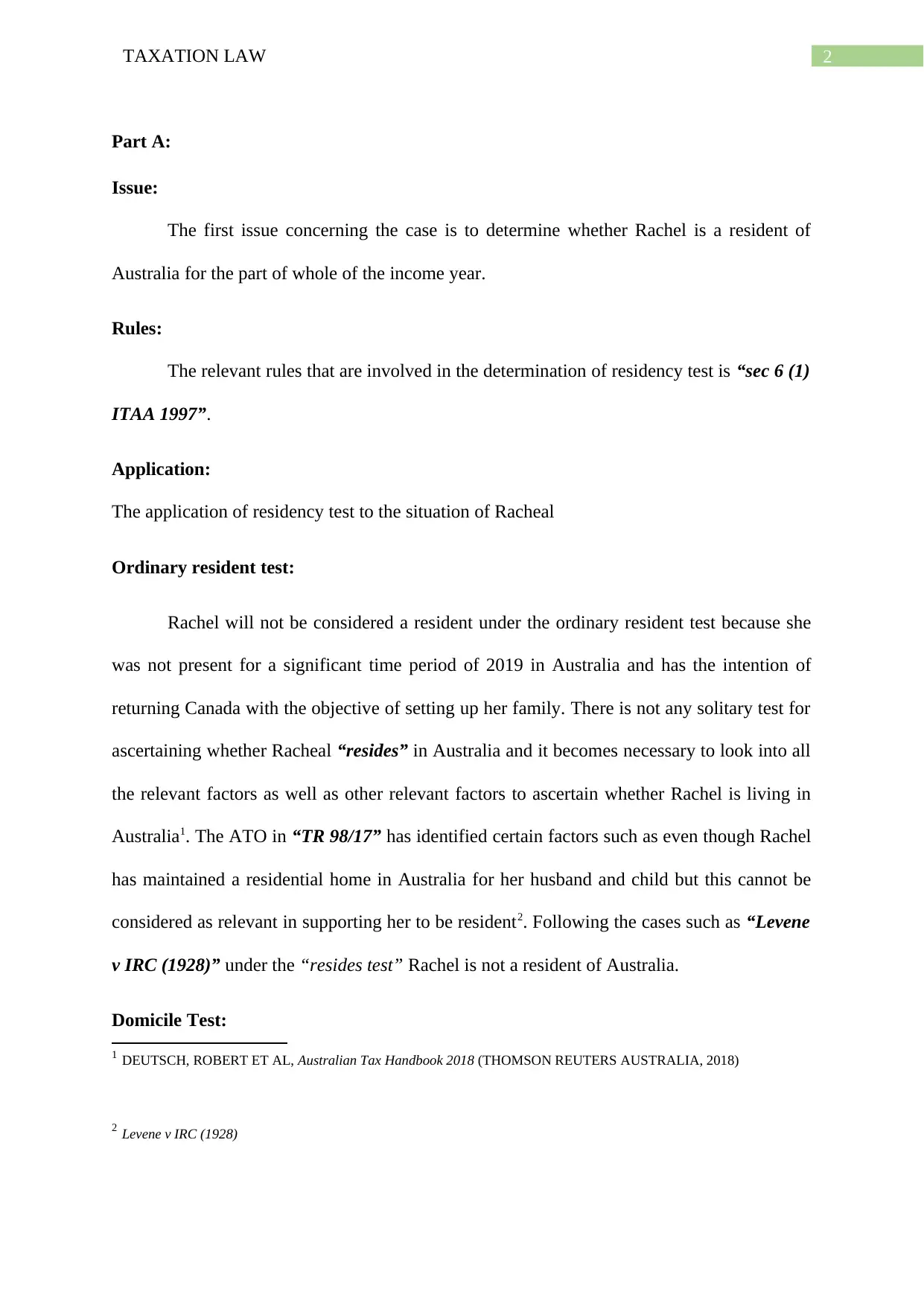
2TAXATION LAW
Part A:
Issue:
The first issue concerning the case is to determine whether Rachel is a resident of
Australia for the part of whole of the income year.
Rules:
The relevant rules that are involved in the determination of residency test is “sec 6 (1)
ITAA 1997”.
Application:
The application of residency test to the situation of Racheal
Ordinary resident test:
Rachel will not be considered a resident under the ordinary resident test because she
was not present for a significant time period of 2019 in Australia and has the intention of
returning Canada with the objective of setting up her family. There is not any solitary test for
ascertaining whether Racheal “resides” in Australia and it becomes necessary to look into all
the relevant factors as well as other relevant factors to ascertain whether Rachel is living in
Australia1. The ATO in “TR 98/17” has identified certain factors such as even though Rachel
has maintained a residential home in Australia for her husband and child but this cannot be
considered as relevant in supporting her to be resident2. Following the cases such as “Levene
v IRC (1928)” under the “resides test” Rachel is not a resident of Australia.
Domicile Test:
1 DEUTSCH, ROBERT ET AL, Australian Tax Handbook 2018 (THOMSON REUTERS AUSTRALIA, 2018)
2 Levene v IRC (1928)
Part A:
Issue:
The first issue concerning the case is to determine whether Rachel is a resident of
Australia for the part of whole of the income year.
Rules:
The relevant rules that are involved in the determination of residency test is “sec 6 (1)
ITAA 1997”.
Application:
The application of residency test to the situation of Racheal
Ordinary resident test:
Rachel will not be considered a resident under the ordinary resident test because she
was not present for a significant time period of 2019 in Australia and has the intention of
returning Canada with the objective of setting up her family. There is not any solitary test for
ascertaining whether Racheal “resides” in Australia and it becomes necessary to look into all
the relevant factors as well as other relevant factors to ascertain whether Rachel is living in
Australia1. The ATO in “TR 98/17” has identified certain factors such as even though Rachel
has maintained a residential home in Australia for her husband and child but this cannot be
considered as relevant in supporting her to be resident2. Following the cases such as “Levene
v IRC (1928)” under the “resides test” Rachel is not a resident of Australia.
Domicile Test:
1 DEUTSCH, ROBERT ET AL, Australian Tax Handbook 2018 (THOMSON REUTERS AUSTRALIA, 2018)
2 Levene v IRC (1928)
⊘ This is a preview!⊘
Do you want full access?
Subscribe today to unlock all pages.

Trusted by 1+ million students worldwide
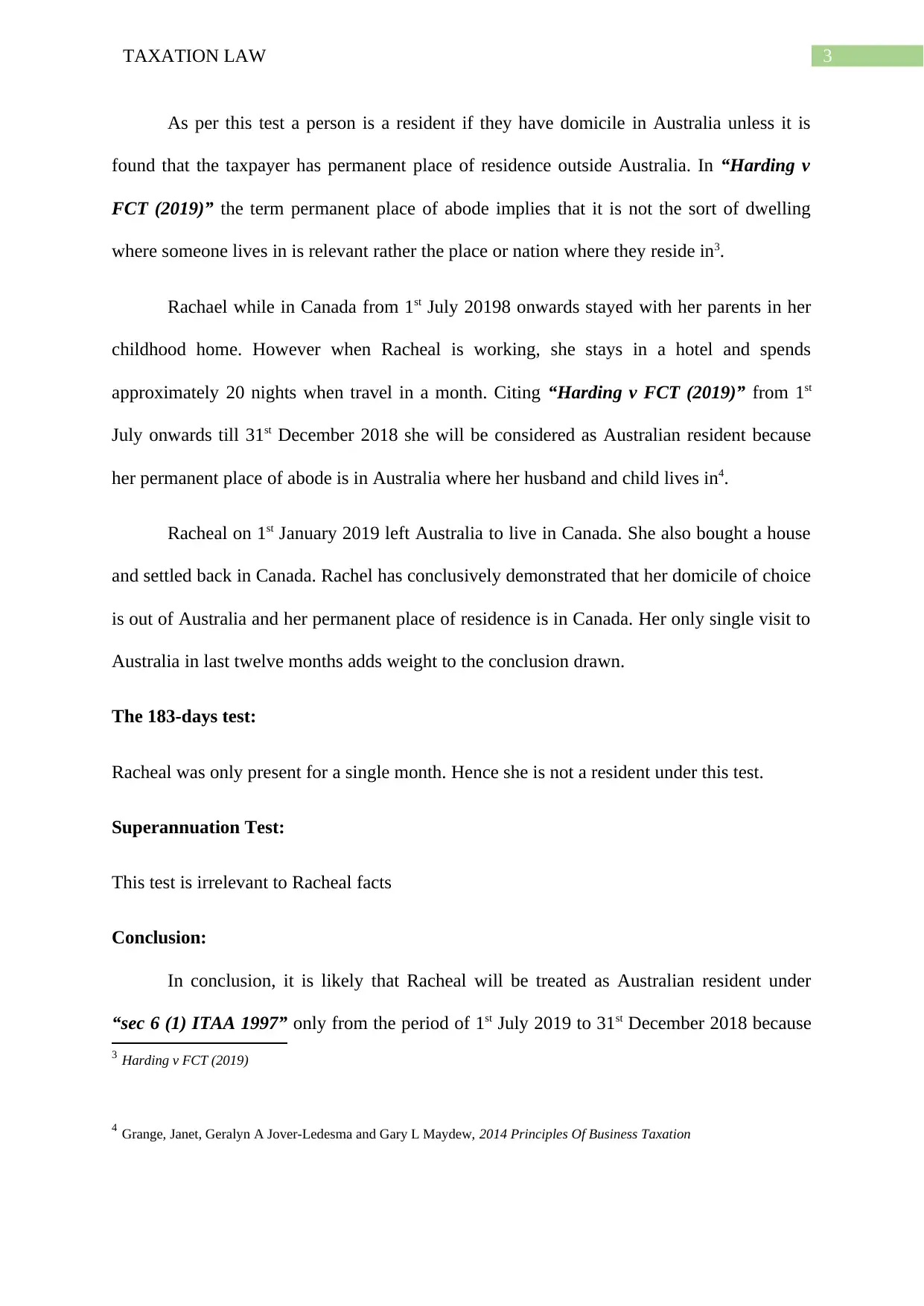
3TAXATION LAW
As per this test a person is a resident if they have domicile in Australia unless it is
found that the taxpayer has permanent place of residence outside Australia. In “Harding v
FCT (2019)” the term permanent place of abode implies that it is not the sort of dwelling
where someone lives in is relevant rather the place or nation where they reside in3.
Rachael while in Canada from 1st July 20198 onwards stayed with her parents in her
childhood home. However when Racheal is working, she stays in a hotel and spends
approximately 20 nights when travel in a month. Citing “Harding v FCT (2019)” from 1st
July onwards till 31st December 2018 she will be considered as Australian resident because
her permanent place of abode is in Australia where her husband and child lives in4.
Racheal on 1st January 2019 left Australia to live in Canada. She also bought a house
and settled back in Canada. Rachel has conclusively demonstrated that her domicile of choice
is out of Australia and her permanent place of residence is in Canada. Her only single visit to
Australia in last twelve months adds weight to the conclusion drawn.
The 183-days test:
Racheal was only present for a single month. Hence she is not a resident under this test.
Superannuation Test:
This test is irrelevant to Racheal facts
Conclusion:
In conclusion, it is likely that Racheal will be treated as Australian resident under
“sec 6 (1) ITAA 1997” only from the period of 1st July 2019 to 31st December 2018 because
3 Harding v FCT (2019)
4 Grange, Janet, Geralyn A Jover-Ledesma and Gary L Maydew, 2014 Principles Of Business Taxation
As per this test a person is a resident if they have domicile in Australia unless it is
found that the taxpayer has permanent place of residence outside Australia. In “Harding v
FCT (2019)” the term permanent place of abode implies that it is not the sort of dwelling
where someone lives in is relevant rather the place or nation where they reside in3.
Rachael while in Canada from 1st July 20198 onwards stayed with her parents in her
childhood home. However when Racheal is working, she stays in a hotel and spends
approximately 20 nights when travel in a month. Citing “Harding v FCT (2019)” from 1st
July onwards till 31st December 2018 she will be considered as Australian resident because
her permanent place of abode is in Australia where her husband and child lives in4.
Racheal on 1st January 2019 left Australia to live in Canada. She also bought a house
and settled back in Canada. Rachel has conclusively demonstrated that her domicile of choice
is out of Australia and her permanent place of residence is in Canada. Her only single visit to
Australia in last twelve months adds weight to the conclusion drawn.
The 183-days test:
Racheal was only present for a single month. Hence she is not a resident under this test.
Superannuation Test:
This test is irrelevant to Racheal facts
Conclusion:
In conclusion, it is likely that Racheal will be treated as Australian resident under
“sec 6 (1) ITAA 1997” only from the period of 1st July 2019 to 31st December 2018 because
3 Harding v FCT (2019)
4 Grange, Janet, Geralyn A Jover-Ledesma and Gary L Maydew, 2014 Principles Of Business Taxation
Paraphrase This Document
Need a fresh take? Get an instant paraphrase of this document with our AI Paraphraser
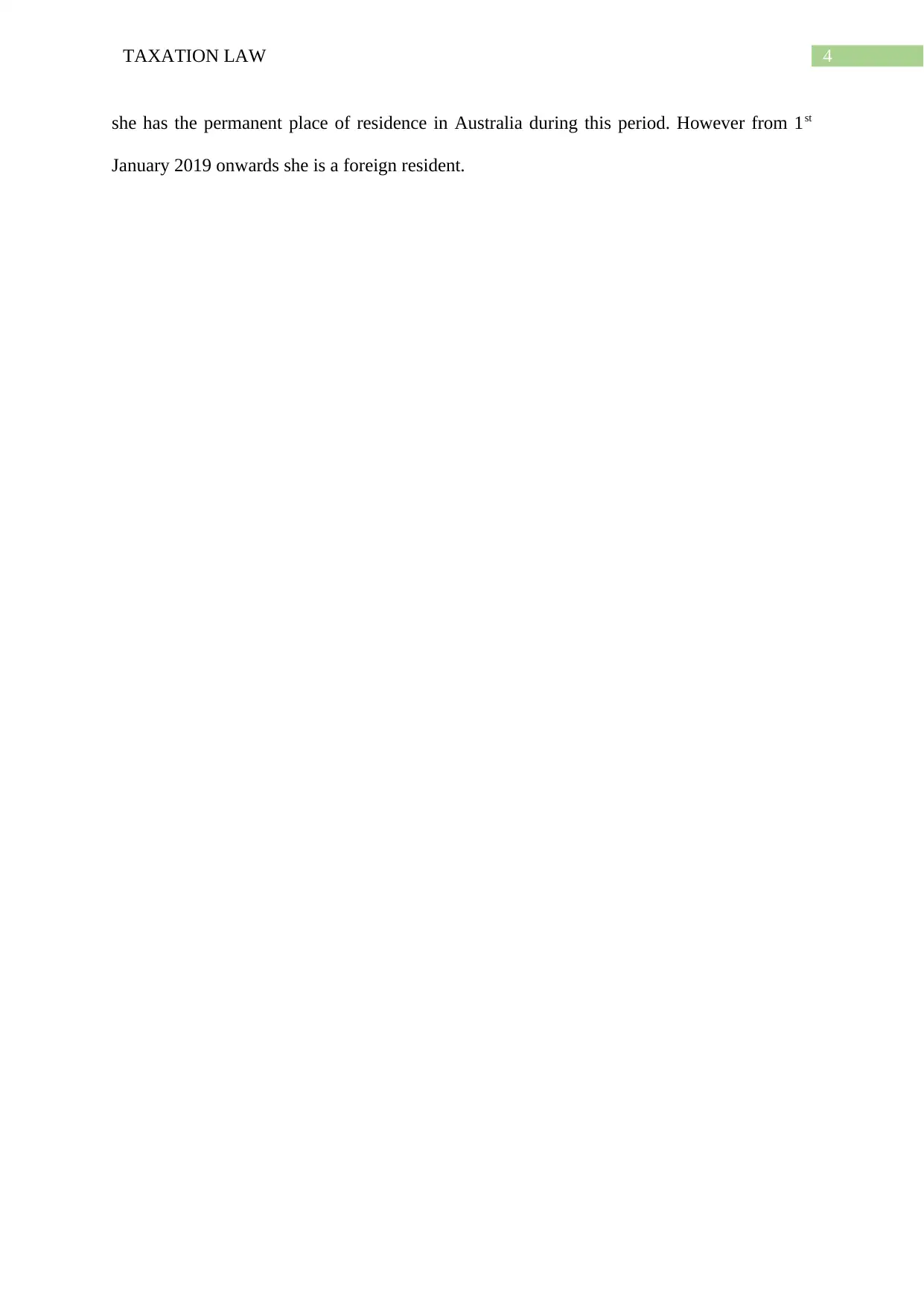
4TAXATION LAW
she has the permanent place of residence in Australia during this period. However from 1st
January 2019 onwards she is a foreign resident.
she has the permanent place of residence in Australia during this period. However from 1st
January 2019 onwards she is a foreign resident.
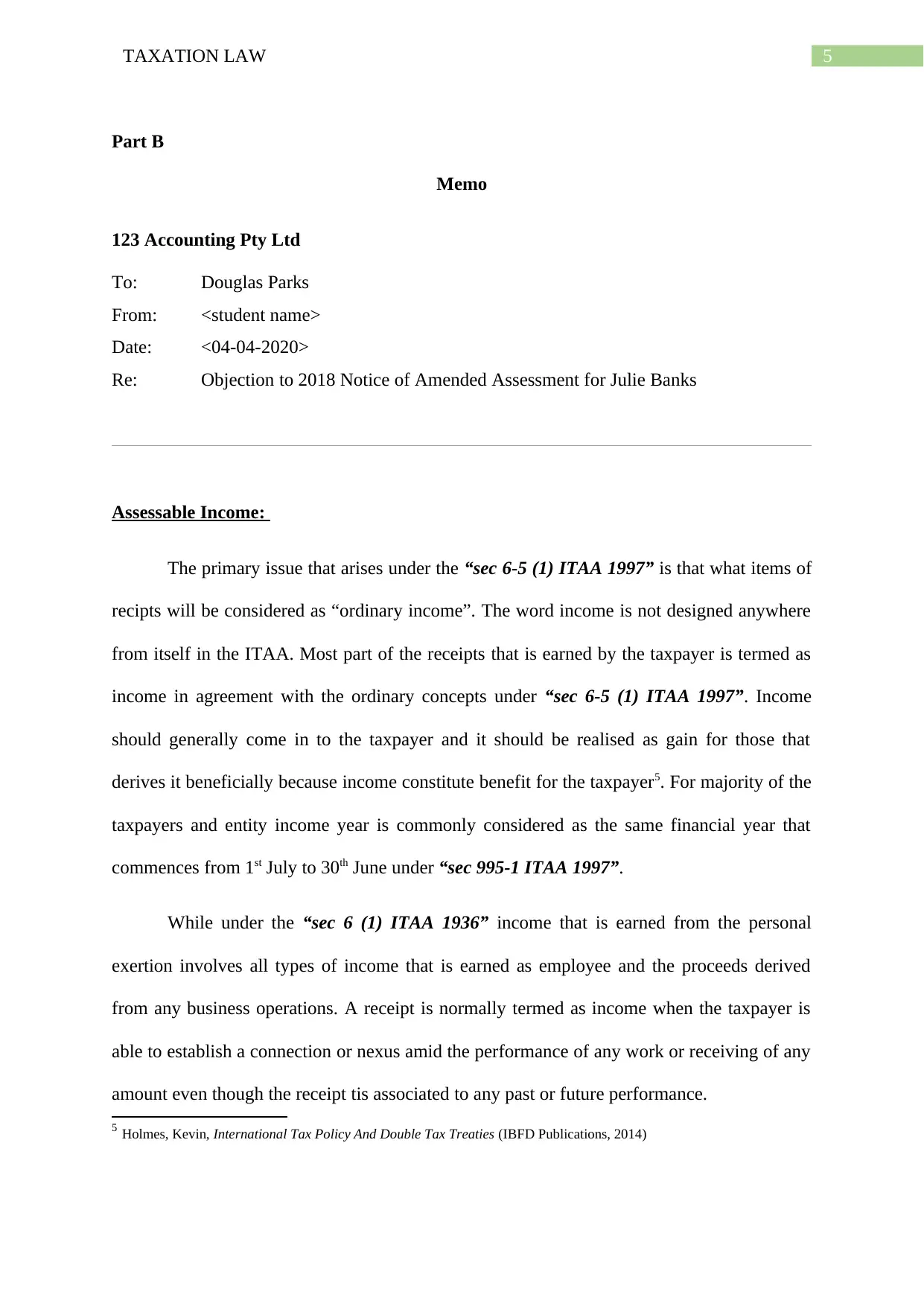
5TAXATION LAW
Part B
Memo
123 Accounting Pty Ltd
To: Douglas Parks
From: <student name>
Date: <04-04-2020>
Re: Objection to 2018 Notice of Amended Assessment for Julie Banks
Assessable Income:
The primary issue that arises under the “sec 6-5 (1) ITAA 1997” is that what items of
recipts will be considered as “ordinary income”. The word income is not designed anywhere
from itself in the ITAA. Most part of the receipts that is earned by the taxpayer is termed as
income in agreement with the ordinary concepts under “sec 6-5 (1) ITAA 1997”. Income
should generally come in to the taxpayer and it should be realised as gain for those that
derives it beneficially because income constitute benefit for the taxpayer5. For majority of the
taxpayers and entity income year is commonly considered as the same financial year that
commences from 1st July to 30th June under “sec 995-1 ITAA 1997”.
While under the “sec 6 (1) ITAA 1936” income that is earned from the personal
exertion involves all types of income that is earned as employee and the proceeds derived
from any business operations. A receipt is normally termed as income when the taxpayer is
able to establish a connection or nexus amid the performance of any work or receiving of any
amount even though the receipt tis associated to any past or future performance.
5 Holmes, Kevin, International Tax Policy And Double Tax Treaties (IBFD Publications, 2014)
Part B
Memo
123 Accounting Pty Ltd
To: Douglas Parks
From: <student name>
Date: <04-04-2020>
Re: Objection to 2018 Notice of Amended Assessment for Julie Banks
Assessable Income:
The primary issue that arises under the “sec 6-5 (1) ITAA 1997” is that what items of
recipts will be considered as “ordinary income”. The word income is not designed anywhere
from itself in the ITAA. Most part of the receipts that is earned by the taxpayer is termed as
income in agreement with the ordinary concepts under “sec 6-5 (1) ITAA 1997”. Income
should generally come in to the taxpayer and it should be realised as gain for those that
derives it beneficially because income constitute benefit for the taxpayer5. For majority of the
taxpayers and entity income year is commonly considered as the same financial year that
commences from 1st July to 30th June under “sec 995-1 ITAA 1997”.
While under the “sec 6 (1) ITAA 1936” income that is earned from the personal
exertion involves all types of income that is earned as employee and the proceeds derived
from any business operations. A receipt is normally termed as income when the taxpayer is
able to establish a connection or nexus amid the performance of any work or receiving of any
amount even though the receipt tis associated to any past or future performance.
5 Holmes, Kevin, International Tax Policy And Double Tax Treaties (IBFD Publications, 2014)
⊘ This is a preview!⊘
Do you want full access?
Subscribe today to unlock all pages.

Trusted by 1+ million students worldwide
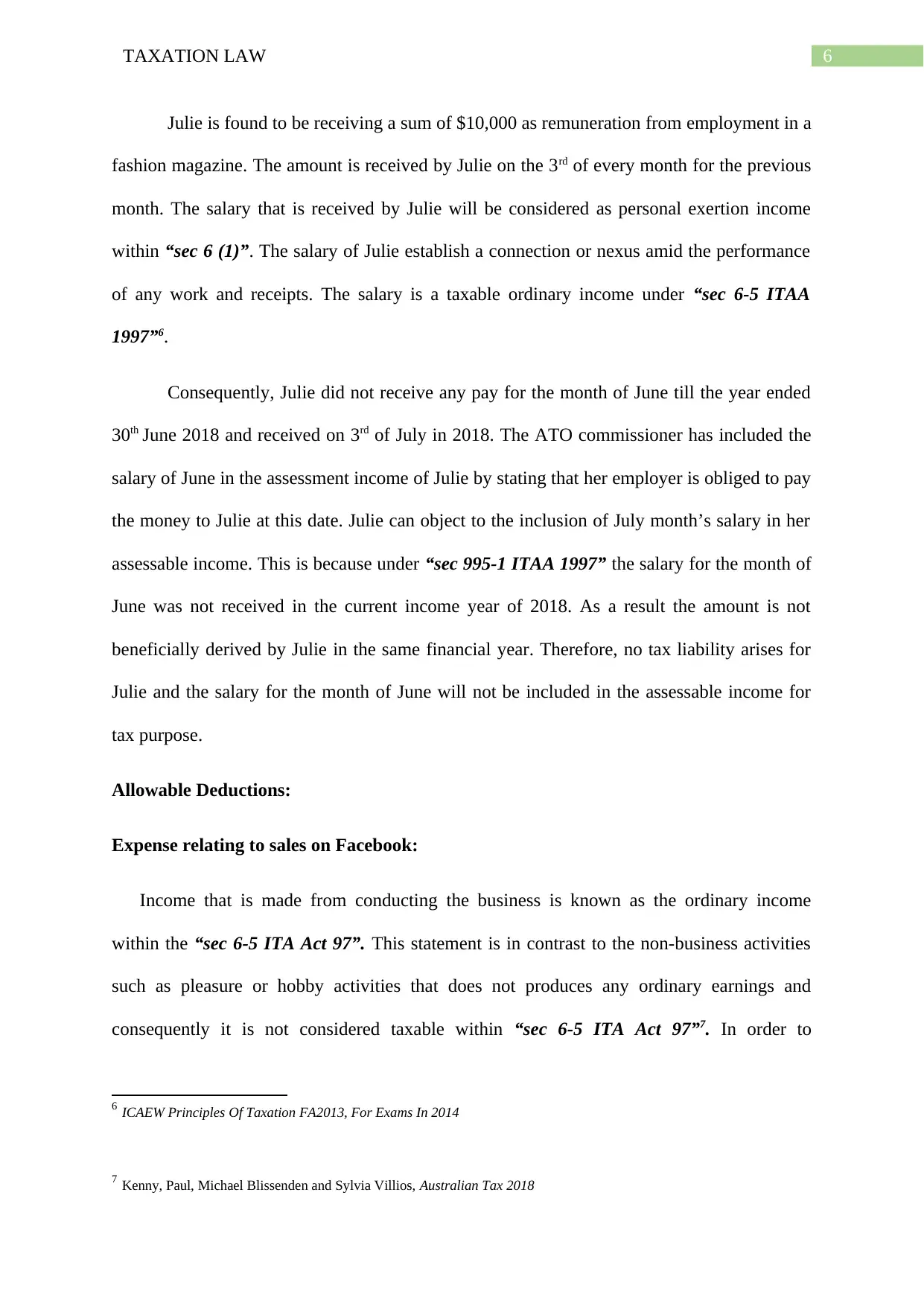
6TAXATION LAW
Julie is found to be receiving a sum of $10,000 as remuneration from employment in a
fashion magazine. The amount is received by Julie on the 3rd of every month for the previous
month. The salary that is received by Julie will be considered as personal exertion income
within “sec 6 (1)”. The salary of Julie establish a connection or nexus amid the performance
of any work and receipts. The salary is a taxable ordinary income under “sec 6-5 ITAA
1997”6.
Consequently, Julie did not receive any pay for the month of June till the year ended
30th June 2018 and received on 3rd of July in 2018. The ATO commissioner has included the
salary of June in the assessment income of Julie by stating that her employer is obliged to pay
the money to Julie at this date. Julie can object to the inclusion of July month’s salary in her
assessable income. This is because under “sec 995-1 ITAA 1997” the salary for the month of
June was not received in the current income year of 2018. As a result the amount is not
beneficially derived by Julie in the same financial year. Therefore, no tax liability arises for
Julie and the salary for the month of June will not be included in the assessable income for
tax purpose.
Allowable Deductions:
Expense relating to sales on Facebook:
Income that is made from conducting the business is known as the ordinary income
within the “sec 6-5 ITA Act 97”. This statement is in contrast to the non-business activities
such as pleasure or hobby activities that does not produces any ordinary earnings and
consequently it is not considered taxable within “sec 6-5 ITA Act 97”7. In order to
6 ICAEW Principles Of Taxation FA2013, For Exams In 2014
7 Kenny, Paul, Michael Blissenden and Sylvia Villios, Australian Tax 2018
Julie is found to be receiving a sum of $10,000 as remuneration from employment in a
fashion magazine. The amount is received by Julie on the 3rd of every month for the previous
month. The salary that is received by Julie will be considered as personal exertion income
within “sec 6 (1)”. The salary of Julie establish a connection or nexus amid the performance
of any work and receipts. The salary is a taxable ordinary income under “sec 6-5 ITAA
1997”6.
Consequently, Julie did not receive any pay for the month of June till the year ended
30th June 2018 and received on 3rd of July in 2018. The ATO commissioner has included the
salary of June in the assessment income of Julie by stating that her employer is obliged to pay
the money to Julie at this date. Julie can object to the inclusion of July month’s salary in her
assessable income. This is because under “sec 995-1 ITAA 1997” the salary for the month of
June was not received in the current income year of 2018. As a result the amount is not
beneficially derived by Julie in the same financial year. Therefore, no tax liability arises for
Julie and the salary for the month of June will not be included in the assessable income for
tax purpose.
Allowable Deductions:
Expense relating to sales on Facebook:
Income that is made from conducting the business is known as the ordinary income
within the “sec 6-5 ITA Act 97”. This statement is in contrast to the non-business activities
such as pleasure or hobby activities that does not produces any ordinary earnings and
consequently it is not considered taxable within “sec 6-5 ITA Act 97”7. In order to
6 ICAEW Principles Of Taxation FA2013, For Exams In 2014
7 Kenny, Paul, Michael Blissenden and Sylvia Villios, Australian Tax 2018
Paraphrase This Document
Need a fresh take? Get an instant paraphrase of this document with our AI Paraphraser
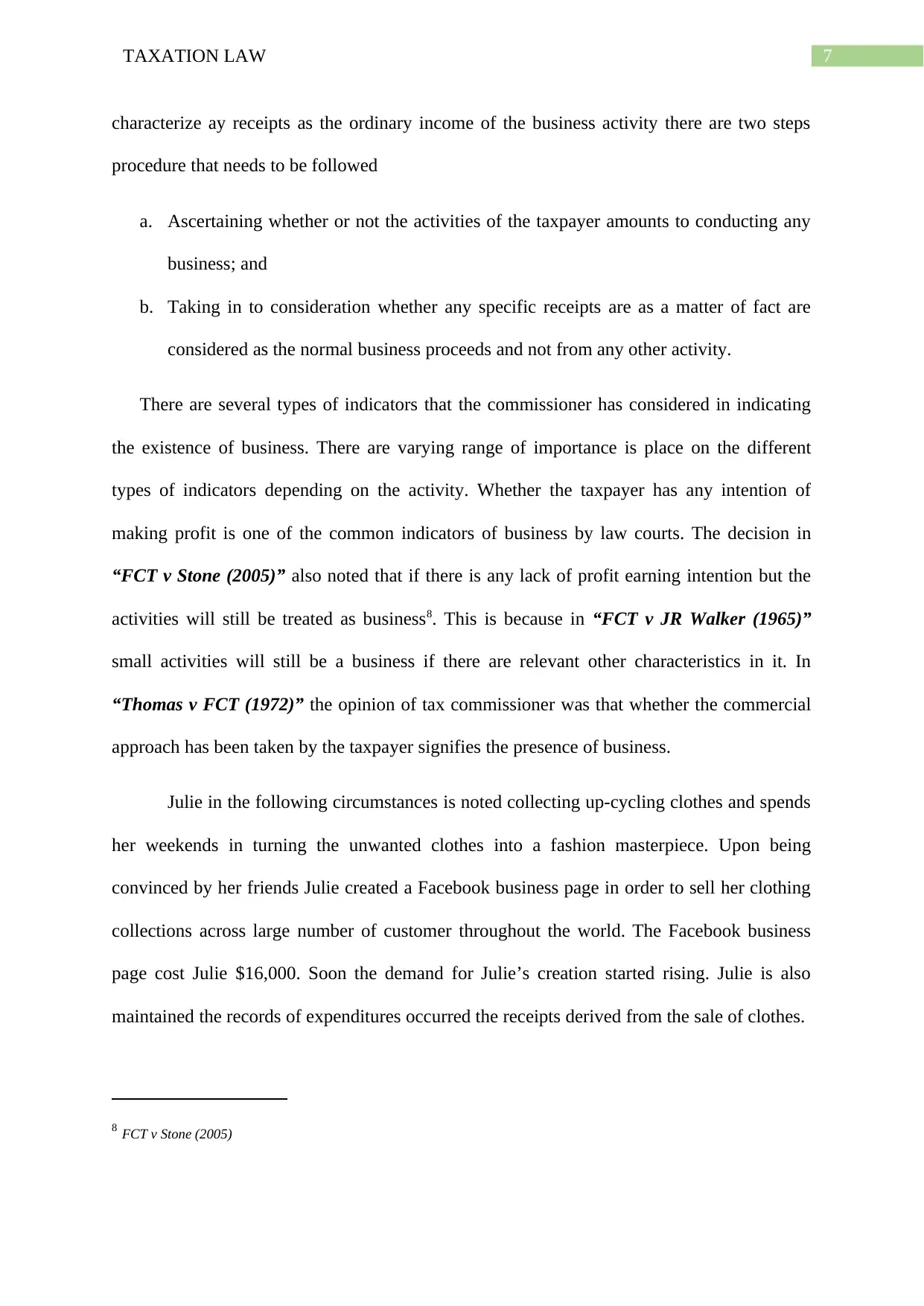
7TAXATION LAW
characterize ay receipts as the ordinary income of the business activity there are two steps
procedure that needs to be followed
a. Ascertaining whether or not the activities of the taxpayer amounts to conducting any
business; and
b. Taking in to consideration whether any specific receipts are as a matter of fact are
considered as the normal business proceeds and not from any other activity.
There are several types of indicators that the commissioner has considered in indicating
the existence of business. There are varying range of importance is place on the different
types of indicators depending on the activity. Whether the taxpayer has any intention of
making profit is one of the common indicators of business by law courts. The decision in
“FCT v Stone (2005)” also noted that if there is any lack of profit earning intention but the
activities will still be treated as business8. This is because in “FCT v JR Walker (1965)”
small activities will still be a business if there are relevant other characteristics in it. In
“Thomas v FCT (1972)” the opinion of tax commissioner was that whether the commercial
approach has been taken by the taxpayer signifies the presence of business.
Julie in the following circumstances is noted collecting up-cycling clothes and spends
her weekends in turning the unwanted clothes into a fashion masterpiece. Upon being
convinced by her friends Julie created a Facebook business page in order to sell her clothing
collections across large number of customer throughout the world. The Facebook business
page cost Julie $16,000. Soon the demand for Julie’s creation started rising. Julie is also
maintained the records of expenditures occurred the receipts derived from the sale of clothes.
8 FCT v Stone (2005)
characterize ay receipts as the ordinary income of the business activity there are two steps
procedure that needs to be followed
a. Ascertaining whether or not the activities of the taxpayer amounts to conducting any
business; and
b. Taking in to consideration whether any specific receipts are as a matter of fact are
considered as the normal business proceeds and not from any other activity.
There are several types of indicators that the commissioner has considered in indicating
the existence of business. There are varying range of importance is place on the different
types of indicators depending on the activity. Whether the taxpayer has any intention of
making profit is one of the common indicators of business by law courts. The decision in
“FCT v Stone (2005)” also noted that if there is any lack of profit earning intention but the
activities will still be treated as business8. This is because in “FCT v JR Walker (1965)”
small activities will still be a business if there are relevant other characteristics in it. In
“Thomas v FCT (1972)” the opinion of tax commissioner was that whether the commercial
approach has been taken by the taxpayer signifies the presence of business.
Julie in the following circumstances is noted collecting up-cycling clothes and spends
her weekends in turning the unwanted clothes into a fashion masterpiece. Upon being
convinced by her friends Julie created a Facebook business page in order to sell her clothing
collections across large number of customer throughout the world. The Facebook business
page cost Julie $16,000. Soon the demand for Julie’s creation started rising. Julie is also
maintained the records of expenditures occurred the receipts derived from the sale of clothes.
8 FCT v Stone (2005)
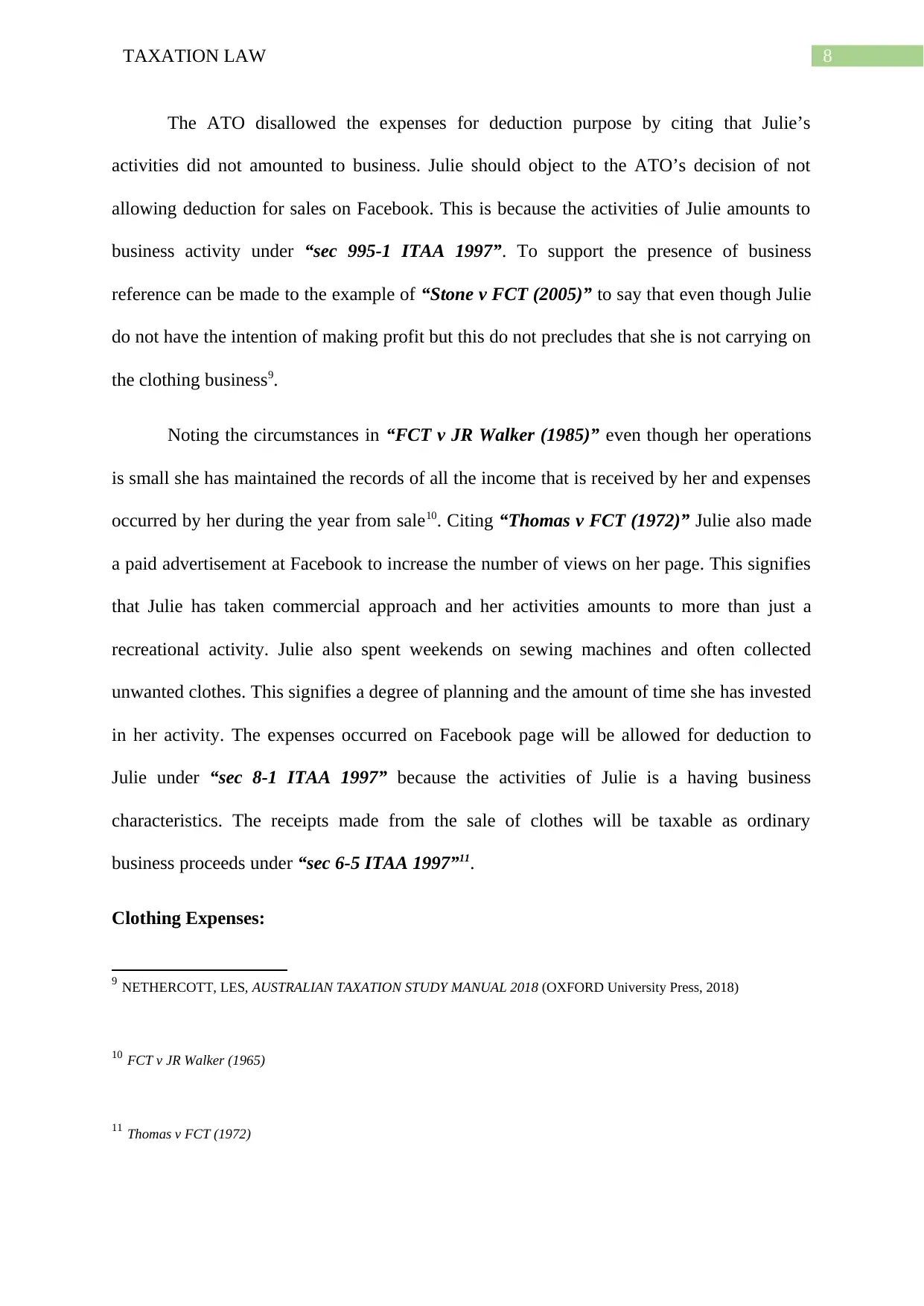
8TAXATION LAW
The ATO disallowed the expenses for deduction purpose by citing that Julie’s
activities did not amounted to business. Julie should object to the ATO’s decision of not
allowing deduction for sales on Facebook. This is because the activities of Julie amounts to
business activity under “sec 995-1 ITAA 1997”. To support the presence of business
reference can be made to the example of “Stone v FCT (2005)” to say that even though Julie
do not have the intention of making profit but this do not precludes that she is not carrying on
the clothing business9.
Noting the circumstances in “FCT v JR Walker (1985)” even though her operations
is small she has maintained the records of all the income that is received by her and expenses
occurred by her during the year from sale10. Citing “Thomas v FCT (1972)” Julie also made
a paid advertisement at Facebook to increase the number of views on her page. This signifies
that Julie has taken commercial approach and her activities amounts to more than just a
recreational activity. Julie also spent weekends on sewing machines and often collected
unwanted clothes. This signifies a degree of planning and the amount of time she has invested
in her activity. The expenses occurred on Facebook page will be allowed for deduction to
Julie under “sec 8-1 ITAA 1997” because the activities of Julie is a having business
characteristics. The receipts made from the sale of clothes will be taxable as ordinary
business proceeds under “sec 6-5 ITAA 1997”11.
Clothing Expenses:
9 NETHERCOTT, LES, AUSTRALIAN TAXATION STUDY MANUAL 2018 (OXFORD University Press, 2018)
10 FCT v JR Walker (1965)
11 Thomas v FCT (1972)
The ATO disallowed the expenses for deduction purpose by citing that Julie’s
activities did not amounted to business. Julie should object to the ATO’s decision of not
allowing deduction for sales on Facebook. This is because the activities of Julie amounts to
business activity under “sec 995-1 ITAA 1997”. To support the presence of business
reference can be made to the example of “Stone v FCT (2005)” to say that even though Julie
do not have the intention of making profit but this do not precludes that she is not carrying on
the clothing business9.
Noting the circumstances in “FCT v JR Walker (1985)” even though her operations
is small she has maintained the records of all the income that is received by her and expenses
occurred by her during the year from sale10. Citing “Thomas v FCT (1972)” Julie also made
a paid advertisement at Facebook to increase the number of views on her page. This signifies
that Julie has taken commercial approach and her activities amounts to more than just a
recreational activity. Julie also spent weekends on sewing machines and often collected
unwanted clothes. This signifies a degree of planning and the amount of time she has invested
in her activity. The expenses occurred on Facebook page will be allowed for deduction to
Julie under “sec 8-1 ITAA 1997” because the activities of Julie is a having business
characteristics. The receipts made from the sale of clothes will be taxable as ordinary
business proceeds under “sec 6-5 ITAA 1997”11.
Clothing Expenses:
9 NETHERCOTT, LES, AUSTRALIAN TAXATION STUDY MANUAL 2018 (OXFORD University Press, 2018)
10 FCT v JR Walker (1965)
11 Thomas v FCT (1972)
⊘ This is a preview!⊘
Do you want full access?
Subscribe today to unlock all pages.

Trusted by 1+ million students worldwide
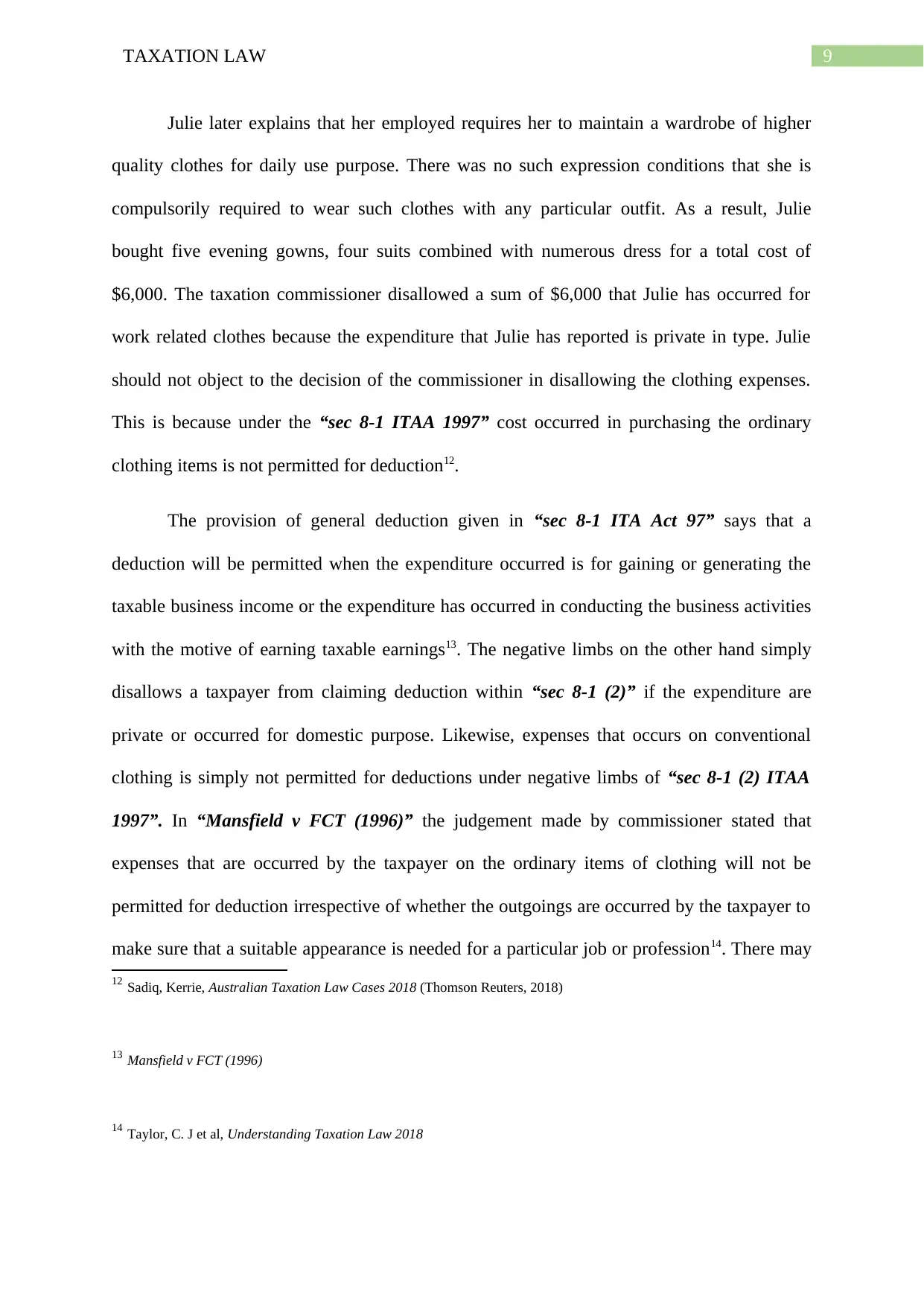
9TAXATION LAW
Julie later explains that her employed requires her to maintain a wardrobe of higher
quality clothes for daily use purpose. There was no such expression conditions that she is
compulsorily required to wear such clothes with any particular outfit. As a result, Julie
bought five evening gowns, four suits combined with numerous dress for a total cost of
$6,000. The taxation commissioner disallowed a sum of $6,000 that Julie has occurred for
work related clothes because the expenditure that Julie has reported is private in type. Julie
should not object to the decision of the commissioner in disallowing the clothing expenses.
This is because under the “sec 8-1 ITAA 1997” cost occurred in purchasing the ordinary
clothing items is not permitted for deduction12.
The provision of general deduction given in “sec 8-1 ITA Act 97” says that a
deduction will be permitted when the expenditure occurred is for gaining or generating the
taxable business income or the expenditure has occurred in conducting the business activities
with the motive of earning taxable earnings13. The negative limbs on the other hand simply
disallows a taxpayer from claiming deduction within “sec 8-1 (2)” if the expenditure are
private or occurred for domestic purpose. Likewise, expenses that occurs on conventional
clothing is simply not permitted for deductions under negative limbs of “sec 8-1 (2) ITAA
1997”. In “Mansfield v FCT (1996)” the judgement made by commissioner stated that
expenses that are occurred by the taxpayer on the ordinary items of clothing will not be
permitted for deduction irrespective of whether the outgoings are occurred by the taxpayer to
make sure that a suitable appearance is needed for a particular job or profession14. There may
12 Sadiq, Kerrie, Australian Taxation Law Cases 2018 (Thomson Reuters, 2018)
13 Mansfield v FCT (1996)
14 Taylor, C. J et al, Understanding Taxation Law 2018
Julie later explains that her employed requires her to maintain a wardrobe of higher
quality clothes for daily use purpose. There was no such expression conditions that she is
compulsorily required to wear such clothes with any particular outfit. As a result, Julie
bought five evening gowns, four suits combined with numerous dress for a total cost of
$6,000. The taxation commissioner disallowed a sum of $6,000 that Julie has occurred for
work related clothes because the expenditure that Julie has reported is private in type. Julie
should not object to the decision of the commissioner in disallowing the clothing expenses.
This is because under the “sec 8-1 ITAA 1997” cost occurred in purchasing the ordinary
clothing items is not permitted for deduction12.
The provision of general deduction given in “sec 8-1 ITA Act 97” says that a
deduction will be permitted when the expenditure occurred is for gaining or generating the
taxable business income or the expenditure has occurred in conducting the business activities
with the motive of earning taxable earnings13. The negative limbs on the other hand simply
disallows a taxpayer from claiming deduction within “sec 8-1 (2)” if the expenditure are
private or occurred for domestic purpose. Likewise, expenses that occurs on conventional
clothing is simply not permitted for deductions under negative limbs of “sec 8-1 (2) ITAA
1997”. In “Mansfield v FCT (1996)” the judgement made by commissioner stated that
expenses that are occurred by the taxpayer on the ordinary items of clothing will not be
permitted for deduction irrespective of whether the outgoings are occurred by the taxpayer to
make sure that a suitable appearance is needed for a particular job or profession14. There may
12 Sadiq, Kerrie, Australian Taxation Law Cases 2018 (Thomson Reuters, 2018)
13 Mansfield v FCT (1996)
14 Taylor, C. J et al, Understanding Taxation Law 2018
Paraphrase This Document
Need a fresh take? Get an instant paraphrase of this document with our AI Paraphraser
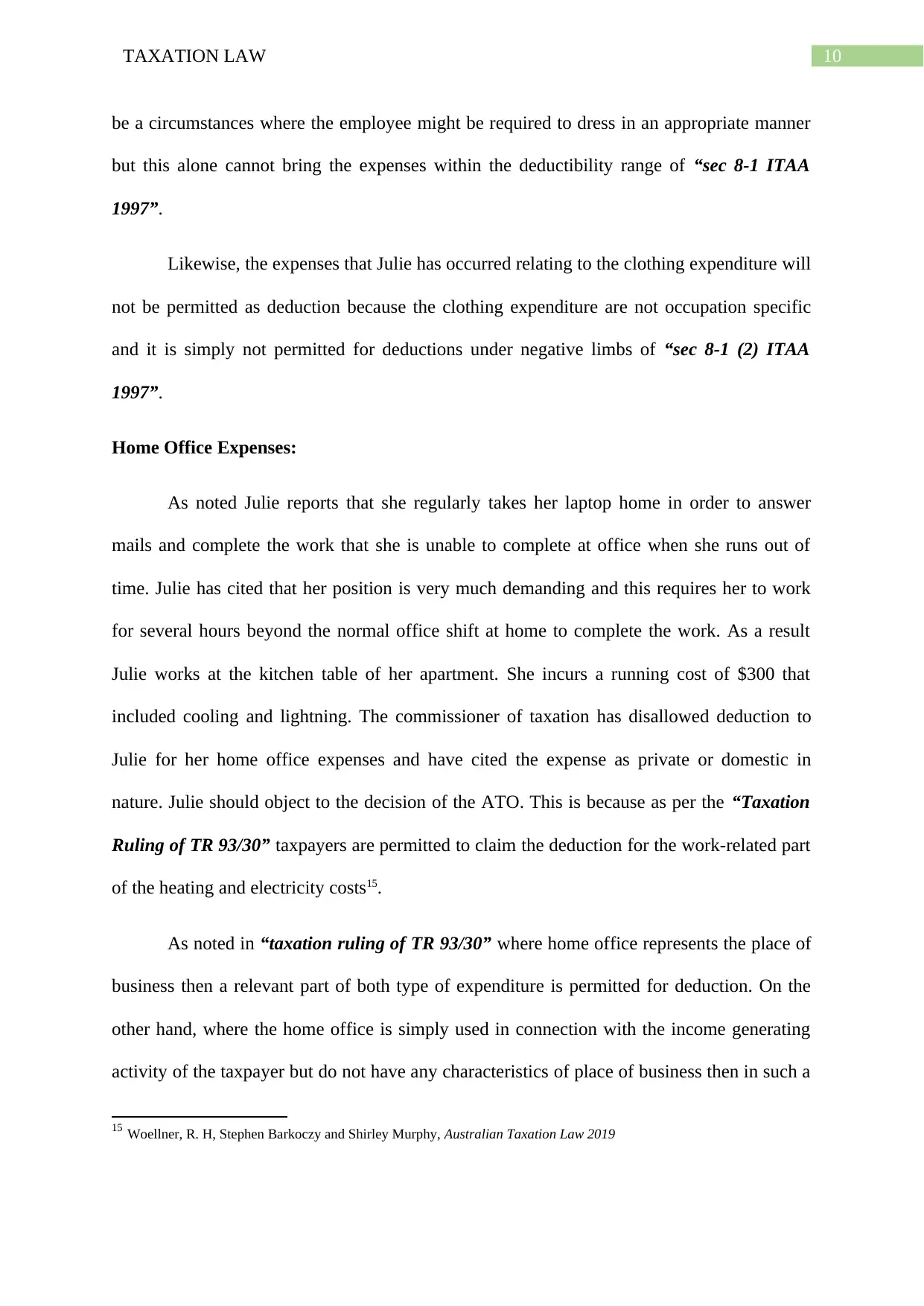
10TAXATION LAW
be a circumstances where the employee might be required to dress in an appropriate manner
but this alone cannot bring the expenses within the deductibility range of “sec 8-1 ITAA
1997”.
Likewise, the expenses that Julie has occurred relating to the clothing expenditure will
not be permitted as deduction because the clothing expenditure are not occupation specific
and it is simply not permitted for deductions under negative limbs of “sec 8-1 (2) ITAA
1997”.
Home Office Expenses:
As noted Julie reports that she regularly takes her laptop home in order to answer
mails and complete the work that she is unable to complete at office when she runs out of
time. Julie has cited that her position is very much demanding and this requires her to work
for several hours beyond the normal office shift at home to complete the work. As a result
Julie works at the kitchen table of her apartment. She incurs a running cost of $300 that
included cooling and lightning. The commissioner of taxation has disallowed deduction to
Julie for her home office expenses and have cited the expense as private or domestic in
nature. Julie should object to the decision of the ATO. This is because as per the “Taxation
Ruling of TR 93/30” taxpayers are permitted to claim the deduction for the work-related part
of the heating and electricity costs15.
As noted in “taxation ruling of TR 93/30” where home office represents the place of
business then a relevant part of both type of expenditure is permitted for deduction. On the
other hand, where the home office is simply used in connection with the income generating
activity of the taxpayer but do not have any characteristics of place of business then in such a
15 Woellner, R. H, Stephen Barkoczy and Shirley Murphy, Australian Taxation Law 2019
be a circumstances where the employee might be required to dress in an appropriate manner
but this alone cannot bring the expenses within the deductibility range of “sec 8-1 ITAA
1997”.
Likewise, the expenses that Julie has occurred relating to the clothing expenditure will
not be permitted as deduction because the clothing expenditure are not occupation specific
and it is simply not permitted for deductions under negative limbs of “sec 8-1 (2) ITAA
1997”.
Home Office Expenses:
As noted Julie reports that she regularly takes her laptop home in order to answer
mails and complete the work that she is unable to complete at office when she runs out of
time. Julie has cited that her position is very much demanding and this requires her to work
for several hours beyond the normal office shift at home to complete the work. As a result
Julie works at the kitchen table of her apartment. She incurs a running cost of $300 that
included cooling and lightning. The commissioner of taxation has disallowed deduction to
Julie for her home office expenses and have cited the expense as private or domestic in
nature. Julie should object to the decision of the ATO. This is because as per the “Taxation
Ruling of TR 93/30” taxpayers are permitted to claim the deduction for the work-related part
of the heating and electricity costs15.
As noted in “taxation ruling of TR 93/30” where home office represents the place of
business then a relevant part of both type of expenditure is permitted for deduction. On the
other hand, where the home office is simply used in connection with the income generating
activity of the taxpayer but do not have any characteristics of place of business then in such a
15 Woellner, R. H, Stephen Barkoczy and Shirley Murphy, Australian Taxation Law 2019
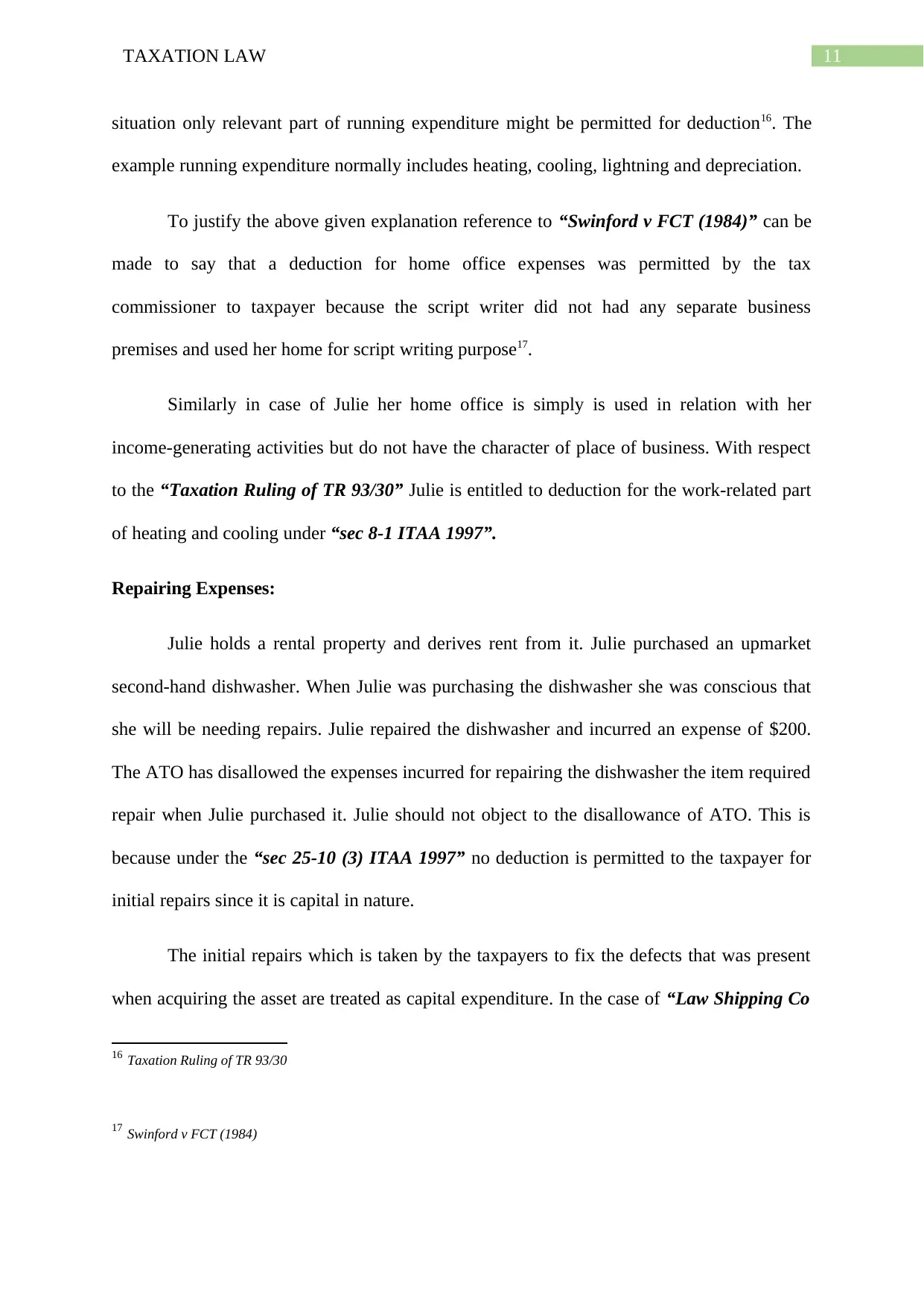
11TAXATION LAW
situation only relevant part of running expenditure might be permitted for deduction16. The
example running expenditure normally includes heating, cooling, lightning and depreciation.
To justify the above given explanation reference to “Swinford v FCT (1984)” can be
made to say that a deduction for home office expenses was permitted by the tax
commissioner to taxpayer because the script writer did not had any separate business
premises and used her home for script writing purpose17.
Similarly in case of Julie her home office is simply is used in relation with her
income-generating activities but do not have the character of place of business. With respect
to the “Taxation Ruling of TR 93/30” Julie is entitled to deduction for the work-related part
of heating and cooling under “sec 8-1 ITAA 1997”.
Repairing Expenses:
Julie holds a rental property and derives rent from it. Julie purchased an upmarket
second-hand dishwasher. When Julie was purchasing the dishwasher she was conscious that
she will be needing repairs. Julie repaired the dishwasher and incurred an expense of $200.
The ATO has disallowed the expenses incurred for repairing the dishwasher the item required
repair when Julie purchased it. Julie should not object to the disallowance of ATO. This is
because under the “sec 25-10 (3) ITAA 1997” no deduction is permitted to the taxpayer for
initial repairs since it is capital in nature.
The initial repairs which is taken by the taxpayers to fix the defects that was present
when acquiring the asset are treated as capital expenditure. In the case of “Law Shipping Co
16 Taxation Ruling of TR 93/30
17 Swinford v FCT (1984)
situation only relevant part of running expenditure might be permitted for deduction16. The
example running expenditure normally includes heating, cooling, lightning and depreciation.
To justify the above given explanation reference to “Swinford v FCT (1984)” can be
made to say that a deduction for home office expenses was permitted by the tax
commissioner to taxpayer because the script writer did not had any separate business
premises and used her home for script writing purpose17.
Similarly in case of Julie her home office is simply is used in relation with her
income-generating activities but do not have the character of place of business. With respect
to the “Taxation Ruling of TR 93/30” Julie is entitled to deduction for the work-related part
of heating and cooling under “sec 8-1 ITAA 1997”.
Repairing Expenses:
Julie holds a rental property and derives rent from it. Julie purchased an upmarket
second-hand dishwasher. When Julie was purchasing the dishwasher she was conscious that
she will be needing repairs. Julie repaired the dishwasher and incurred an expense of $200.
The ATO has disallowed the expenses incurred for repairing the dishwasher the item required
repair when Julie purchased it. Julie should not object to the disallowance of ATO. This is
because under the “sec 25-10 (3) ITAA 1997” no deduction is permitted to the taxpayer for
initial repairs since it is capital in nature.
The initial repairs which is taken by the taxpayers to fix the defects that was present
when acquiring the asset are treated as capital expenditure. In the case of “Law Shipping Co
16 Taxation Ruling of TR 93/30
17 Swinford v FCT (1984)
⊘ This is a preview!⊘
Do you want full access?
Subscribe today to unlock all pages.

Trusted by 1+ million students worldwide
1 out of 17
Related Documents
Your All-in-One AI-Powered Toolkit for Academic Success.
+13062052269
info@desklib.com
Available 24*7 on WhatsApp / Email
![[object Object]](/_next/static/media/star-bottom.7253800d.svg)
Unlock your academic potential
Copyright © 2020–2025 A2Z Services. All Rights Reserved. Developed and managed by ZUCOL.





